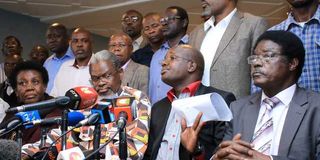VCs on the spot over new pay deal for varsity staff

Universities Academic Staff Union chairman Muga K’Olale (second left) and other officials on January 17. Lecturers have accused universities of paying out their new salaries in a discriminatory manner.
What you need to know:
- Dr Bosire claims some of the money meant for staff has been “misdirected” to other expenses such as settling debts, which he says was illegal.
- Prof Gitahi attributes the misunderstanding on a failure to understand the role of the SRC in the payouts and the universities funding model.
Lecturers and university staff have accused vice-chancellors of implementing the Sh6.6 billion Collective Bargaining Agreement payout in a biased, discriminatory and obscure way, denying some of them thousands of shillings in arrears.
They say the payout method is shrouded in secrecy in most universities and that there are huge discrepancies among lecturers in the same grade and with similar teaching experience, which should not be the case.
“We will need to do an audit of how the payments were done in all universities, but I want to assure the lecturers that none of them will lose a single cent of what is due to them in the CBA. We will clear up the confusion,” said University Academic Staff Union secretary general Constantine Wasonga.
He said a joint meeting of the negotiation team will meet today to clear up the confusion and set the way forward.
Same grade
“The confusion is everywhere. Some universities have paid what they should have yet others have not. How can two people in the same grade and with the same number of years in service be paid different amounts in arrears. We need to get to the bottom of this confusion,” said Dr Henry Omosa, the Uasu organising secretary Kisii University chapter.
While Dr Omosa says a majority of the lecturers across Kenya’s public universities are unhappy with the implementation of the CBA, University of Nairobi (UON) seem to bear the brunt of the discontent and anger.
“Why was the implementation committee not involved in deciding who was to be paid what? Why wasn’t the union consulted and why were we paid only half of what the State gave us?” poses Dr Richard Bosire the chairman of the University of Nairobi’s Uasu chapter.
Dr Bosire claims some of the money meant for staff has been “misdirected” to other expenses such as settling debts, which he says was illegal.
Disbursed funds
He said the union has written to the vice-chancellor, Prof Stephen Kiama Gitahi, explaining the grievances and demanding details on how the payments were made.
The union has demanded to see the letter that disbursed the funds from the Ministry of Education, the Salaries Remuneration Committee (SRC) implementation guidelines, the payment schedules and a declaration of any surplus funds after the payment of arrears among other details.
“We have not received a word from the chairman of the joint implementation committee nor from the VC even though we have sent several reminders to them,” says Dr Bosire.
However, Prof Gitahi attributes the misunderstanding on a failure to understand the role of the SRC in the payouts and the universities funding model.
“The SRC gave us tables on how to implement the CBA and it’s based on the individual as opposed to the union depending on where you are and your grade. Individuals can demand the data on how the figures were arrived at,” he said on the telephone.
He added that the State does not give universities money based on a CBA but on the student enrolment figures and the courses. “Since the SRC came into the picture, the role of the unions in determining the actual payments after negotiations was curtailed,” he added.
Prof Gitahi’s argument follows the shift of Government funding in the 2017/2018 financial year from a flat rate for every academic programme to model based on the Differentiated Unit Cost (DUC). The VC says the new funding model resulted in the reduction of Government capitation to large universities.
“UoN lost about Sh1.7 billion. The DUC overlooked the unique human resource structure of the university which is top heavy compared to all other universities because of the high concentration of professors and the expansion of the institution into several functional campuses spanning across four counties,” he says. He adds that the expansion has come at a huge cost in terms of operational expenses and overheads compared to smaller and newer institutions.
144 professors
“If the DUC is based on the cost of running a programme and the number of students in it, how can the gap be bridged if the calculated DUC is less that the recommendations of the SRC and the CBA?” poses Prof Gitahi, adding that the DUC model fails to take into account post graduate students and UON has more students in this segment than any other university.
Because it is the country’s oldest and largest, UON has the largest concentration of academic staff with 144 professors, 215 associate professors, 405 senior lecturers, 612 lecturers and 245 assistant lecturers, bringing the total to 1,621.
“These numbers may have changed this year because of internal promotions or recruitment but what is significant is that the university has highest number of lecturers and thus the cost of running a programme here is significantly higher,” he said.
“The output of these lecturers is what makes the university ranked among the top in the continent and therefore any funding mechanism must put this into consideration,” adds Prof Gitahi.
The university was last month ranked top in Kenya, 10th in Africa and 956 in the world by Webometrics, a ranking system for the world’s universities and which takes into account an institution’s online presence and the impact of the web publications.




